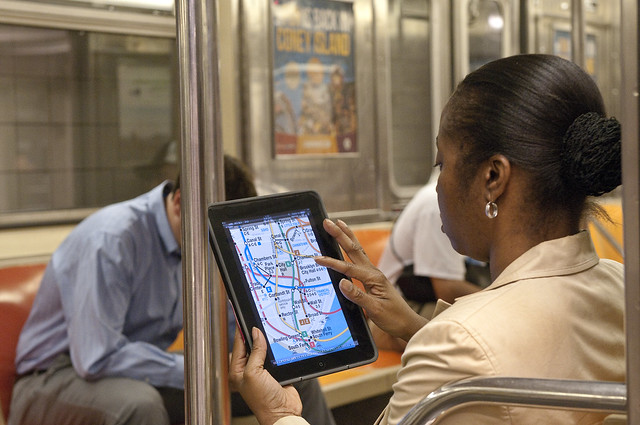
The countdown clocks at Nevins St. last summer forecasted a long wait. (Photo by Benjamin Kabak)
It’s funny to see how technology can take over our lives. We grow so accustomed to something we didn’t have before — something we might have gone years or decades without — but once it’s there, we can’t live without it. When it’s gone, things don’t seem right, and we grow impatient. We want it back. We want it to work. We want that convenience.
A few years ago, the only countdown clocks in New York were a part of a pilot program along the L line. They usually worked (although sometimes threatened 54-minute waits for trains that were just a few stations away), and only a small subset of subway riders had the chance to enjoy them. Today, that picture has changed as countdown clocks are available at nearly every A Division station. If I have a choice between two rides, I’ll pick the route with the clocks. It makes waiting for a train seem like an exercise in calm patience instead of frustrated futility.
That said, the countdown clocks are far from perfect. They’re still very much a work in progress and as they like to remind us, undergoing tests. As with any computer equipment, extreme temperatures seem to cause them trouble, and I’ve received some recent complaints about outages at 86th St. on the East Side IRT and other high-volume stops where passengers grew to depend on the clocks. Considering we didn’t have them a few years ago, straphangers clearly appreciate and depend on the key bits of information these signs provide.
Yet, even as the countdown clocks provide straphanger who are waiting for trains with some modicum of peace of mind, they have their limitations. We might know how far away the next train is based on an algorithm that uses the subway system’s signals, but the people in the stations who are supposed to help out do not have access to the same information.
Take, for instance, this tale posted to Subchat last night. With a 12-9 in the Bronx causing a diversion along the 2 and 5 line, a man and his niece had to negotiate a variety of changes, block tickets and transfers between buses and subways to reach a station being serviced, and along the way, they encountered a bus driver, a station agent and an MTA Customer Service representative on the phone. None of the people they spoke with had the right information about the service change or the fare policies.
I’ve long beaten the customer service drum on Second Ave. Sagas, and over the past few years, the MTA has seemingly tried to improve the way they relate to their customers. But it’s a two-way street. We might benefit from the countdown clocks, but once installed, those are a very passive way of delivering information. The MTA still doesn’t have an efficient way to inform their workers in the field what’s happening or coordinate updates between those folks on the phone and those workers overseeing changes. Thus, customers looking for reroutes are often left in the cold.
When the Fulton St. Transit Center opens in 2014, it will, according to a NY1 report, have all electronic signage. “We will not have paper any longer,” MTA Capital Construction President Michael Horodniceanu said. “When you see, for example, a sign sending you to, let’s say the A, C, 4, 5 and so forth, it will be in electronic fashion that will emulate the way the signs look today.”
Electronic signage can be great for customization. If train designations are changed, if routes are altered, they can be updated with a push of a button. If something is temporarily wrong, they can be used to broadcast that message. Ultimately, though, if no one is there to coordinate updates and provide timely information, real-time delivery solutions can only be one half of a customer service product, and it takes two to tango.



 As the MTA has struggled over the years to fit technology into their offerings, their online customer support has lagged far behind the technology we see in the system. Countdown clocks and FIND displays are incongruous with the way the MTA had, up until recently, treated its web presence. Take, for example, a MetroCard.
As the MTA has struggled over the years to fit technology into their offerings, their online customer support has lagged far behind the technology we see in the system. Countdown clocks and FIND displays are incongruous with the way the MTA had, up until recently, treated its web presence. Take, for example, a MetroCard.


 While the demise of the MetroCard is still a few years away, the MTA already knows what its next-generation fare payment technology will resemble. In fact, the authority has produced a 140-page “Concept of Operations” that includes, according to the authority, “a detailed definition of what the MTA wants the system to do.” It does not, however, offer a technical solution for the system, and to that end, the authority will present its new fare payment system to an extensive group of industry experts this week.
While the demise of the MetroCard is still a few years away, the MTA already knows what its next-generation fare payment technology will resemble. In fact, the authority has produced a 140-page “Concept of Operations” that includes, according to the authority, “a detailed definition of what the MTA wants the system to do.” It does not, however, offer a technical solution for the system, and to that end, the authority will present its new fare payment system to an extensive group of industry experts this week.